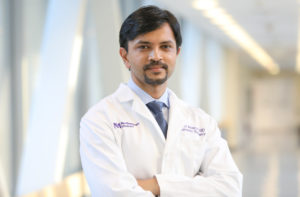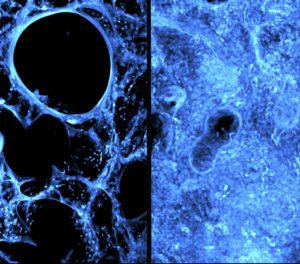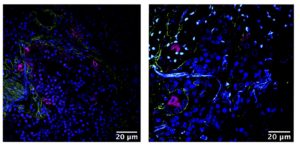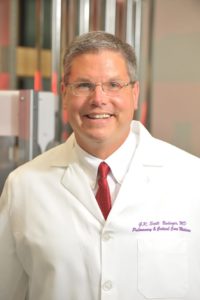
Double lung transplantation may be a life-saving treatment for patients with COVID-19-associated fibrotic lung damage, according to a Northwestern Medicine study published in Science Translational Medicine.
Northwestern Medicine surgeons have performed several of these surgeries so far, and used new imaging techniques to analyze the damaged lung tissue, finding that COVID-19 can produce irreversible damage in some patients — for which a double lung transplant may be the only option for survival.
“Matrix imaging shows, for the first time, that COVID-19 destroys the basic framework of the lung — that’s what makes it unrecoverable in some patients,” said Ankit Bharat, MBBS, the Harold L. and Margaret N. Method Research Professor of Surgery, chief of Thoracic Surgery and lead author of the study.
As the COVID-19 pandemic continues, scientists and clinicians continue to discover more about the short- and long-term effects of the disease. While most people return to normal health after the infection, other patients have long-term complications in the cardiovascular system, respiratory system and the brain.

In the cases reported in the study, patients experienced lung failure and required mechanical ventilation. Many of these patients, who were transferred to Northwestern from medical centers around the country, had exhausted all other treatment options by the time they arrived in Chicago.
The double lung transplant surgery is grueling, stretching to 12 hours long in some cases, and is paired with a long and complex recovery. The lungs are one of the only organs that are exposed to external air and must withstand pathogens, pollution and other irritants — so transplanted lungs are predisposed to complications, Bharat said.
While the double lung transplant may appear to be a difficult undertaking, it was the last resort for many patients. Using a newly-developed extracellular matrix imaging technique combined with single-cell RNA sequencing, Bharat and other collaborators examined the damaged lung tissue from three patients who underwent transplants and also from patients who died from COVID-19-associated pneumonia.
The investigators found severe damage resembling that of end-stage pulmonary fibrosis. In addition, RNA sequencing allowed the investigators to “map” the lungs of COVID-19 patients onto those of fibrosis patients, a tool that could one day identify which patients are recovering well and which patients might require a transplant.

Curiously, patients who died from early-stage disease had less damage compared to patients who died long after the virus had left the body — raising the possibility that this damage is not wrought by the virus, but by the body itself.
“That’s why we think this is likely not related to the virus, but instead the after-effects, because the virus has triggered mechanisms that lead to destruction or ongoing inflammation in the immune system,” said Bharat, who is also an associate professor of Medicine in the Division of Pulmonary and Critical Care
The long-term effects of COVID-19 are beginning to come into focus, but findings such as these underline the importance of tracking patients who have recovered from COVID-19, according to Scott Budinger, MD, the Ernest S. Bazley Professor of Airway Diseases, chief of Pulmonary and Critical Care in the Department of Medicine, and senior author of the study.

“Funding to develop a research infrastructure to follow COVID-19 survivors and measure long-term outcomes including fibrosis is urgently needed, so fibrosis and other complications can be included as a secondary outcome in these studies,” said Budinger, who is also a professor of Cell and Developmental Biology.
At Northwestern, Budinger and a large multi-disciplinary team have started a clinical program to follow COVID-19 survivors, cataloguing symptoms and functional limitations in an effort to learn more about the long-term symptoms of COVID-19.
“We are too early in the course at this time to know if these symptoms and limitations are secondary to fibrosis, but the tools we describe in this paper will help,” Budinger said.
Budinger and Bharat are members of the Robert H. Lurie Comprehensive Center of Northwestern University.
This work was supported by National Institutes of Health (NIH) grants HL145478, HL147290, HL147575, U19AI135964, P01AG049665, P01AG049665, R01HL147575, U19AI135964 and R01HL153312; NUCATS COVID-19 Rapid Response Grant; CZI Seed Networks for the Human Cell Atlas; and Veterans Affairs grant I01CX001777.






